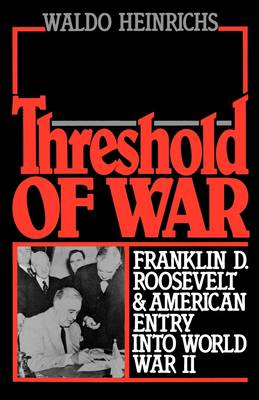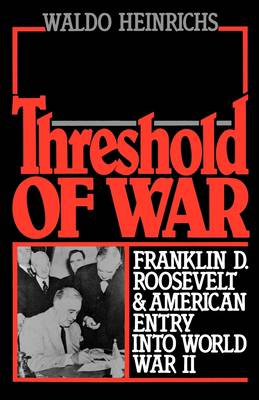
- Afhalen na 1 uur in een winkel met voorraad
- Gratis thuislevering in België vanaf € 30
- Ruim aanbod met 7 miljoen producten
- Afhalen na 1 uur in een winkel met voorraad
- Gratis thuislevering in België vanaf € 30
- Ruim aanbod met 7 miljoen producten
Zoeken
Threshold of War
Franklin D. Roosevelt and American Entry Into World War II
Waldo Heinrichs
Paperback | Engels
€ 66,45
+ 132 punten
Omschrijving
As the first comprehensive treatment of the American entry into World War II to appear in over thirty-five years, Waldo Heinrichs' volume places American policy in a global context, covering both the European and Asian diplomatic and military scenes, with Roosevelt at the center.
Telling a tale of ever-broadening conflict, this vivid narrative weaves back and forth from the battlefields in the Soviet Union, to the intense policy debates within Roosevelt's administration, to the sinking of the battleship Bismarck, to the precarious and delicate negotiations with Japan. Refuting the popular portrayal of Roosevelt as a vacillating, impulsive man who displayed no organizational skills in his decision-making during this period, Heinrichs presents him as a leader who acted with extreme caution and deliberation, who always kept his options open, and who, once Hitler's invasion of the Soviet Union stalled in July, 1941, acted rapidly and with great determination. This masterful account of a key moment in American history captures the tension faced by Roosevelt, Churchill, Stimson, Hull, and numerous others as they struggled to shape American policy in the climactic nine months before Pearl Harbor.
Telling a tale of ever-broadening conflict, this vivid narrative weaves back and forth from the battlefields in the Soviet Union, to the intense policy debates within Roosevelt's administration, to the sinking of the battleship Bismarck, to the precarious and delicate negotiations with Japan. Refuting the popular portrayal of Roosevelt as a vacillating, impulsive man who displayed no organizational skills in his decision-making during this period, Heinrichs presents him as a leader who acted with extreme caution and deliberation, who always kept his options open, and who, once Hitler's invasion of the Soviet Union stalled in July, 1941, acted rapidly and with great determination. This masterful account of a key moment in American history captures the tension faced by Roosevelt, Churchill, Stimson, Hull, and numerous others as they struggled to shape American policy in the climactic nine months before Pearl Harbor.
Specificaties
Betrokkenen
- Auteur(s):
- Uitgeverij:
Inhoud
- Aantal bladzijden:
- 302
- Taal:
- Engels
Eigenschappen
- Productcode (EAN):
- 9780195061680
- Verschijningsdatum:
- 1/03/1990
- Uitvoering:
- Paperback
- Formaat:
- Trade paperback (VS)
- Afmetingen:
- 141 mm x 217 mm
- Gewicht:
- 385 g

Alleen bij Standaard Boekhandel
+ 132 punten op je klantenkaart van Standaard Boekhandel
Beoordelingen
We publiceren alleen reviews die voldoen aan de voorwaarden voor reviews. Bekijk onze voorwaarden voor reviews.











